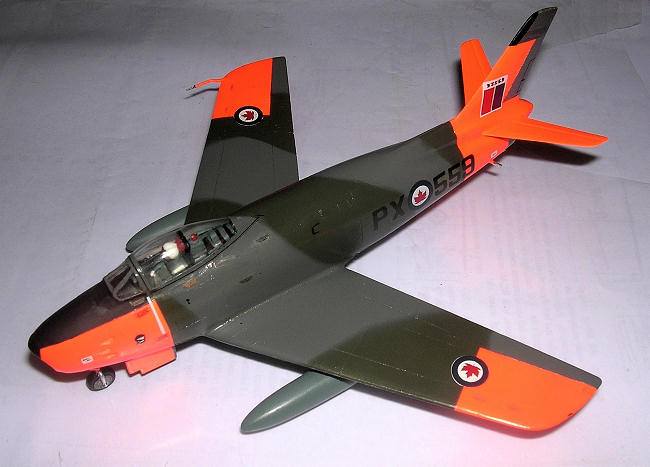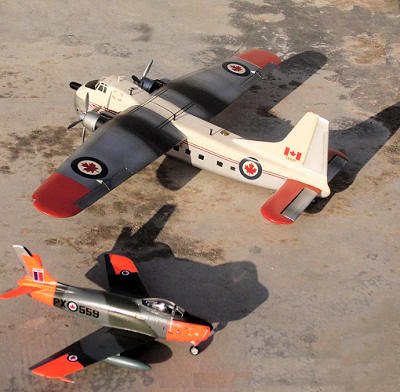
Frog 1/72 Sabre F.6
| KIT #: | ? |
| PRICE: | $? |
| DECALS: | Apparently so |
| REVIEWER: | Carmel J. Attard |
| NOTES: |

| HISTORY |
The first Canadair
CL-13 Sabre built in quantity was the Mk2. This corresponded to the USAF’s
F-86E, which was powered by J47-GE-13 engine, and 350 were built. The Mk4 was
also powered by same type of engine. The only Canadair Sabre Mk3 built used the
prototype Orenda engine that was flown by Jacqueline Cochrane to raise the
woman’s speed record to 625 mph. The Mk4 also introduced a different wing, which
had extension of 6” at the root and 3” at the tip. The Mk 5 was similarly
equipped but had the Orenda 10 engine giving an increased rate of climb. In all
370 were built followed by the Mk6, which was the definitive version and was
powered by Orenda 14. The first example flew on
| THE KIT |
The Sabre always
appealed to me as an ideal interceptor fighter but was inspired to build the
Canadian Sabre after I encountered a photo and side view drawing of it in
Aviation News Vol 5 No 4 which also contained scale plans of the type at the
center pages. In due course I also built up a particular attraction for thos e
colourschemes carrying high visibility markings. This is normally associated
with combat aircraft that are attached to test and evaluation programmes; or
aircraft operating in the arctic region; transport aircraft; and trainers. The
Canadian Sabre subject easily fitted in this class of fancy colourscheme with
the high visibility day-glow orange at areas on the fuselage and wings. It
sounds contradictory to have a camouflaged aircraft with high visibility
markings but this is the way it goes and such schemes existed to mention a few:
RAF Canberras, Dutch Beavers, Pakistan AF Otters, Saudi Strikemasters, Danish
Dakotas, and Greek Buckeyes etc etc.
e
colourschemes carrying high visibility markings. This is normally associated
with combat aircraft that are attached to test and evaluation programmes; or
aircraft operating in the arctic region; transport aircraft; and trainers. The
Canadian Sabre subject easily fitted in this class of fancy colourscheme with
the high visibility day-glow orange at areas on the fuselage and wings. It
sounds contradictory to have a camouflaged aircraft with high visibility
markings but this is the way it goes and such schemes existed to mention a few:
RAF Canberras, Dutch Beavers, Pakistan AF Otters, Saudi Strikemasters, Danish
Dakotas, and Greek Buckeyes etc etc.
Frog issued the Sabre kit many years ago. Injected in grayish silver plastic of thick section, it was very basic with lots of rivets, wheel wells non existent, also included lead weight to assist kit balance on nose wheel, crew figure integrally molded with the rest of cockpit. Air intake and canopy of incorrect shape and the undercarriage was very basic which needed definite replacement. The instruction sheet consisted of a drawing depicting the few parts in an exploded view. The kit also came with a pair of fuel tanks but these were smaller than the ones used on the operational aircraft and were at best discarded. The decal sheet was also basic with markings for one RAF Sabre.
| CONSTRUCTION |
 Checking
the kit with scale plans by Aviation News, the wing swept angle was conforming
however each wing was 3.5mm too long at the tips, so this was corrected
accordingly. The heavy riveting detail on this old Frog kit was all removed and
new panel lines and air brake panels were re-scribed. The tail planes were
grossly oversize and were replaced with a new set coming from the Heller f-86E.
The nose air intake was of incorrect shape and again replaced with one from the
Heller Kit, as were also the undercarriage parts. The fin and rudder were
reduced and reshaped to conform to scale plans. The Orenda 14 engines had
slightly larger exhaust orifice than J-47GE-13 on the F-86 and so the fuselage
of the old Frog kit proved useful for the type. The kit fuel tanks were too
small and again replaced with a set from the Heller kit.
Checking
the kit with scale plans by Aviation News, the wing swept angle was conforming
however each wing was 3.5mm too long at the tips, so this was corrected
accordingly. The heavy riveting detail on this old Frog kit was all removed and
new panel lines and air brake panels were re-scribed. The tail planes were
grossly oversize and were replaced with a new set coming from the Heller f-86E.
The nose air intake was of incorrect shape and again replaced with one from the
Heller Kit, as were also the undercarriage parts. The fin and rudder were
reduced and reshaped to conform to scale plans. The Orenda 14 engines had
slightly larger exhaust orifice than J-47GE-13 on the F-86 and so the fuselage
of the old Frog kit proved useful for the type. The kit fuel tanks were too
small and again replaced with a set from the Heller kit.
The cockpit was
rebuilt, adding an adequate ejection seat, crew figure, shoulder straps,
instrument panel and control column and all the corresponding interior paint
detail that easily was visible in a clear canopy. Building the cockpit also
meant that I had to find alternative space in place of the slot provided to take
the  weight
capsule provided to get the model sit on its landing gear. The front jet intake
nose was cut vertically with a saw blade and the new one fitted from the Heller
kit. An outlet jet orifice was made from a plastic pipe from spares box and
fitted at the aft fuselage. Nose wheel well was marked and cut, its walls built
and the undercarriage inserted. A new nose wheel door was built from plastic
card. New fuel tanks, pylons, and undercarriage items and a clear canopy parts
all came from the Heller F-86 kit. A metal pitot tube was bent to shape and
fitted to the starboard wing tip. A stubby metal drainpipe was also added to aft
engine area, port side.
weight
capsule provided to get the model sit on its landing gear. The front jet intake
nose was cut vertically with a saw blade and the new one fitted from the Heller
kit. An outlet jet orifice was made from a plastic pipe from spares box and
fitted at the aft fuselage. Nose wheel well was marked and cut, its walls built
and the undercarriage inserted. A new nose wheel door was built from plastic
card. New fuel tanks, pylons, and undercarriage items and a clear canopy parts
all came from the Heller F-86 kit. A metal pitot tube was bent to shape and
fitted to the starboard wing tip. A stubby metal drainpipe was also added to aft
engine area, port side.
| COLORS & MARKINGS |
The Sabre Mk 6 23559,
 enamel
paints. For the upper surface camouflage of ocean grey and dark green I used
Hannants Xtracrylic XA1044 RAF dark sea grey and XA1001 RAF Dark Green. The
model was then given a coat of Klear prior to putting on the decals.
enamel
paints. For the upper surface camouflage of ocean grey and dark green I used
Hannants Xtracrylic XA1044 RAF dark sea grey and XA1001 RAF Dark Green. The
model was then given a coat of Klear prior to putting on the decals.
Markings were cobbled together from many aftermarket decal sheets. Particularly stash from Micro scale 1/72-decal sheets that I collected over the years. The Canadian roundels came from decal sheet CAN-FORCE-DECALS CF-1, the fuselage letters and serial No from Hales Frogelite sheet of the required size letters, small stenciling from Micro Scale Decal Sheet No 72-100. The nose markings of this particular Sabre consisting of the word Queenie and Wand on starboard side of nose were hand painted, as also was the CAPE/AAED crest on both sides of nose. Red white blue fin flash was cut to size and stuck on a white decal sheet so that it leaves a white periphery around the flash on both sides. Some of the decals were old, so I painted the sheet with Klear liquid before cutting the individual decals apart. The coating will seal the decal to the paper permanently. After decaling the model was coated in semi matt Model Master varnish.
| CONCLUSIONS |
 Overall
this project took twice the time it would have taken for a kit built straight
from the box. The extra work done to produce a Sabre Mk6 was worth the effort as
it is a kit with a difference and more enjoyment is gained from the conversion
itself. It is imperative to research the subject well and get the appropriate
decals for it. This kit should appeal in particular to Canadian modelers who
want a Sabre Mk6 complete with unique attractive colors.
Overall
this project took twice the time it would have taken for a kit built straight
from the box. The extra work done to produce a Sabre Mk6 was worth the effort as
it is a kit with a difference and more enjoyment is gained from the conversion
itself. It is imperative to research the subject well and get the appropriate
decals for it. This kit should appeal in particular to Canadian modelers who
want a Sabre Mk6 complete with unique attractive colors.
| REFERENCES |
Aviation News Vol 5
No 4 issued
D
Copyright ModelingMadness.com. All rights reserved. No reproduction in any form without express permission from the editor.
 If you would like your product reviewed fairly and quickly, please
contact
the editor or see other details in the
Note to
Contributors.
If you would like your product reviewed fairly and quickly, please
contact
the editor or see other details in the
Note to
Contributors.